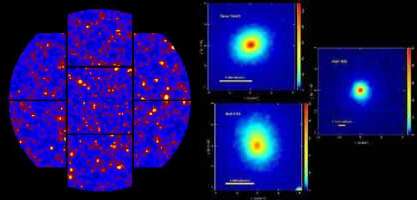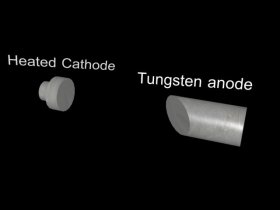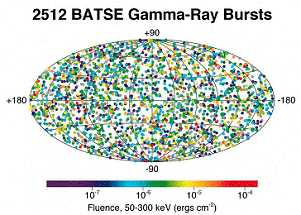


The most common source of UV radiation is the Sun. It is what gives us our suntans, or sunburn if you are not careful. the UV region is divided into three further categories:
| UVA (320 - 400 nm) |
| UVB (280 - 320 nm) |
| UVC (100 - 280 nm) |
Most UVA rays from the Sun penetrate the Earth's atmosphere to reach the Earth surface. These therefore are the ones we protect ourselves from mostly by using sun cream. UVB rays are strongly absorbed by ozone and so the intensity at the Earth's surface is much lower than that of UVA rays. Finally UVC rays are strongly absorbed by ozone and so the intensity at the Earth's surface is near zero.

Another example of the use of UV light is in the detection of forged bank notes.
The optical monitor in XMM is also sensitive to UV light, and because it is above the Earth's atmosphere which absorbs much of the UV light incident on the Earth it receives a much higher intensity of UV light than any ground based instrument.
X-ray region
This is the region most important to the XMM telescope. The X-rays that XMM observes come from sources such as galaxies, black holes, and quasars. X-rays are produced by objects such as galaxies and black holes because of the high temperatures found there, temperatures in excess of a million Kelvin.

On the left is an image taken from XMM of a region of space containing numerous X-ray galaxies. On the right is a number of close up images of X-ray galaxies. As you can see the greatest emission comes from the centre of the galaxies as this is the hottest region.
The Earth's atmosphere strongly absorbs X-rays of low and medium energy. At sea level one cm of air can reduce the intensity of low energy X-rays by a factor of 1000 and medium energy X-rays by a factor of 10.

Please move the mouse over the image
X-rays are produced in the laboratory by accelerating electrons at a target material such as tungsten. The process by which X-rays are produced is Bremsstrahlung (braking radiation). This is where radiation is emitted due to the deceleration of the electrons passing into the target material.
Gamma ray region
Gamma rays have the shortest wavelength and highest energy of all electromagnetic waves. They are produced in decaying radioactive materials, nuclear explosions and in high energy events such as in a supernova explosion when a massive star dies. They are harmful to living cells, but this negative effect is utilized in medicine to kill cancerous cells in the body.
Gamma rays, like most of the electromagnetic spectrum cannot penetrate deeply through the Earth's atmosphere so gamma ray astronomy was not achieved until balloons or spacecraft could gain sufficient altitude. In 1961 the first gamma ray telescope was only able to detect 100 gamma ray photons.
Gamma ray astronomy is very useful because high energy gamma rays come from regions deep in stars and galaxies, and shows up events such as solar flares, and energy radiated from black holes.
Gamma ray bursts (GRBs) are astronomical events that produce intense "bursts" of gamma rays. It was suggested prior to 1991 that the source of these events was neutron stars, but the Burst and Transient Source Experiment (BATSE) has been able to see many of these events in a fairly isotropic pattern across the sky. This suggests that neutron stars are not the source. Data from the XMM telescope has however provided strong evidence that GRB could be caused by supernova explosions.

This image shows an all sky map of gamma ray bursts. These are unpredictable events whose origin is still a hot topic of debate.
![]()
previous page

